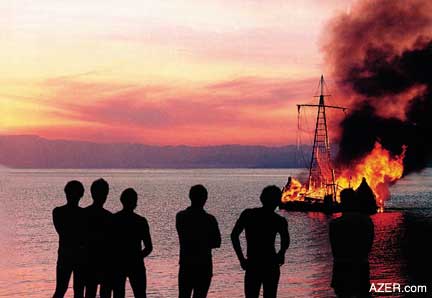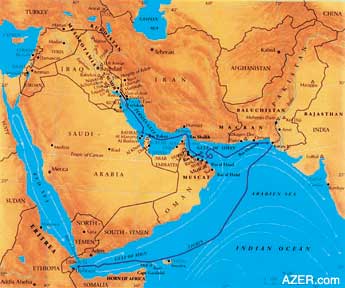|

Spring 2003 (11.1)
Pages
20-21
25 Years Ago
Heyerdahl
Burns "Tigris" Reed Ship to Protest War
Story by Betty Blair
and Bjornar Storfjell
Letter to UN by Thor Heyerdahl

Above: On April 3, 1978, after their five-month-4,200-mile-oceanic
voyage, Thor Heyerdahl (center) and his 10-man crew burn their
reed ship Tigris in protest of the wars raging in the Middle
East. (Photo by Kon-Tiki Museum, Oslo).
Other articles
related to Thor Heyerdahl in Azerbaijan International:
(1) Thor Heyerdahl in Azerbaijan: KON-TIKI
Man
by Betty Blair (AI 3:1, Spring 1995)
(2) The Azerbaijan Connection: Challenging
Euro-Centric Theories of Migration by Heyerdahl (AI 3:1, Spring 1995)
(3) Azerbaijan's
Primal Music Norwegians Find 'The Land We Come From' by Steinar Opheim (AI
5.4, Winter 1997)
(4) Thor
Heyerdahl in Baku
(AI 7:3, Autumn 1999)
(5) Scandinavian
Ancestry: Tracing Roots to Azerbaijan - Thor Heyerdahl (AI 8.2, Summer 2000)
(6) Quote:
Earlier Civilizations - More Advanced - Thor Heyerdahl (AI 8.3, Autumn 2000)
(7) The
Kish Church - Digging Up History - An Interview with J. Bjornar Storfjel
(AI 8.4, Winter 2000)
(8) Adventurer's
Death Touches Russia's Soul - Constantine Pleshakov (AI 10.2,
Summer 2002)
(9) First
Encounters in the Soviet Union - Thor Heyerdahl (AI 10.2,
Summer 2002)
(10) Thor
Heyerdahl's Final Projects - Bjornar Storfjell (AI 10.2,
Summer 2002)
(11) Voices
of the Ancients: Rare Caucasus Albanian Text - Dr. Zaza Alexidze
(AI 10.2, Summer 2002)
In 1995, the late Thor Heyerdahl, world-renown anthropologist
and archaeologist, honored Azerbaijan International magazine
by choosing us to be the first place where he documented his
belief that Scandinavian ancestors came from the region now inhabited
by Azerbaijanis. See "The Azerbaijan Connection: Challenging
Euro-Centric Theories of Migration," Azerbaijan International
3.1 (Spring 1995). Search at AZER.com.
Heyerdahl passed away last year on April 18, 2002. No doubt if
he were here with us today, he would have something to say about
the explosive situation that has developed in the exact region
where one of his reed ship experiments originated - Iraq.
Twenty-five years ago, on April
3, 1978, Thor Heyerdahl (19142002) was just completing a
4,200-mile voyage on a 60-foot reed ship known as the Tigris.
His journey had started at the place many consider to be the
birth of civilization - the verdant valley between the Euphrates
and Tigris rivers in Iraq. Setting sail from the banks of the
Tigris, Thor and his crew navigated down the Persian Gulf to
Oman and eastward to the Indus Delta of Pakistan. Then they reversed
direction and headed southwest back across the Indian Ocean in
the direction of the Horn of Africa. It was the last of Thor's
four trans-oceanic voyages, the first being the well-known 1949
Kon-Tiki voyage made on a balsawood raft from the coast of Peru
to the Polynesian Islands.
The Tigris' crew comprised 11 multinational members: Thor Heyerdahl
(Norway), navigator Norman Baker (USA), art student and interpreter
Rashad Nazi Salim (Iraq), underwater cameraman Toru Suzuki (Japan),
professional photographer Norris Brock (USA), young navy captain
Detlef Zoltzek (Germany), physician Yuri Senkevitch (USSR), mountain
climber and expert with ropes Carlo Mauri (Italy), amateur archaeologist
Ghermán Carrasco (Mexico) and students Hans Petter Bohn
(Norway) and Asbjørn Damhus (Denmark).
  Left: Voyage of the Tigris from Iraq, to
Iran, Pakistan and the Horn of Africa. (Photo by Kon-Tiki Museum) Left: Voyage of the Tigris from Iraq, to
Iran, Pakistan and the Horn of Africa. (Photo by Kon-Tiki Museum)
After surviving the
treacherous five-month journey at sea, Thor had wanted to end
his voyage in the port of Mitsiwa (now Massawa) on the western
(African) side of the Red Sea. It was through this port that
he had originally brought the reeds from Lake Tana in Ethiopia
for the building of two earlier experimental ships, Ra I and
Ra II.
No Place to Land
But Ethiopia was involved with a breakaway war with the Eritreans.
Nearby Somalia was at war, too. On the opposite side of the Gulf
of Aden, civil war had erupted in Yemen. Thor and his crew decided
to try to steer in the middle of the Gulf between Yemen and Somalia.
However, when the winds died down, navigating the primitive reed
craft became extremely difficult and they began drifting towards
the island of Socotra, which belonged to South Yemen and on which
the Soviets were installing military hardware at that time. Eventually,
they had no choice but to land in the newly established African
nation of Djibouti, a small neutral country squeezed in between
Somalia and Ethiopia.
They had survived on sea, only to be denied a place to land because
the entire region was engulfed in war. In the end, Heyerdahl
decided to torch the Tigris, setting it ablaze as a bonfire for
peace, protesting the wars that were raging, fueled by arms sales
by the major Western powers, including the Soviet Union. The
crew members stood on the coral reef in silent awe at the ironic
fate of the Tigris, watching the hoisted sails flare up like
a torch as the red sunset disappeared behind the dark African
mountains.
Burning the Tigris was a difficult decision for Thor, but it
was also his way of not letting the ship rot amidst the warships
and man-made pollution found in the harbor off Djibouti. Also
it meant that no one would be able to exploit the ship for their
own commercial benefit. Saddam Hussein, too, had been eager to
use the reed ship for his own public relations purposes, as it
had originally been assembled in Iraq. Heyerdahl's earlier vessels,
the Kon-Tiki (made of balsa logs) and Ra II (made of reed), are
both on exhibition at the Kon Tiki Museum in Norway.
  Left: The Tigris, a 60-foot reed boat based
on designs used by Early Man, proved early civilizations were
capable of long migrations by sea and ocean. (Photo by Kon-Tiki Museum) Left: The Tigris, a 60-foot reed boat based
on designs used by Early Man, proved early civilizations were
capable of long migrations by sea and ocean. (Photo by Kon-Tiki Museum)
Heyerdahl's experiment,
like his previous voyages, again proved that early man could
have successfully navigated immense distances across seas and
oceans thousands of years ago. The Tigris, constructed of buoyant
river reeds, had been a fine sea-worthy vessel.
On April 3, 1978, Heyerdahl wrote the following Open Letter to
Secretary-General Kurt Waldheim of the United Nations to explain
why he had burned his ship as a desperate plea for world cooperation.
His call for sanity is as relevant today as it was 25 years ago.
Open Letter to
UN
Heyerdahl sent the following Open Letter to Secretary General
Waldheim from the Republic of Djibouti, Africa on April 3, 1978.
As the multinational crew of the experimental reed ship Tigris
brings the test voyage to its conclusion today, we are grateful
to the Secretary-General for the permission to have sailed under
United Nations' flag, and we are proud to report that the double
objectives of the expedition [of succeeding on a transoceanic
voyage with a primitive craft manned by an international crew]
have been achieved to our complete satisfaction.
Ours has been a voyage into the past to study the qualities of
a prehistoric type of vessel built upon ancient Sumerian principles.
But it has also been a voyage into the future to demonstrate
that no space is too restricted for peaceful coexistence of men
who work for common survival. We are 11 men from countries governed
by different political systems. We have sailed together on a
small raft-ship of tender reeds and rope a distance of over 6,000
km [4,200 miles] from the Republic of Iraq by way of the Emirates
of Bahrain, the Sultanate of Oman and the Republic of Pakistan
to the newly-born African nation of Djibouti.
We are able to report that in spite of different political views,
we have lived and struggled together in perfect understanding
and friendship, shoulder to shoulder in cramped quarters through
calm and storms, always according to the ideals of the United
Nations: cooperation for joint survival. When we embarked last
November on our reed-ship Tigris, we knew we would sink or survive
together, and this knowledge united us in friendship. When we
now, in April, disperse to our respective homelands, we sincerely
respect and feel sympathy for each other's nations.
Our joint message is not directed to any one country but to modern
man everywhere. We have shown that the ancient people in Mesopotamia,
the Indus Valley and Egypt could have built man's earliest civilizations
through the benefit of mutual contact with the primitive vessels
at their disposal 5,000 years ago. Culture arose through intelligent
and profitable exchange of thoughts and products.
Today we burn our proud ship, though the sails and rigging are
still up and the vessel is in perfect shape, to protest against
inhuman elements in the world of 1978 to which we have come back
as we reach land after sailing the open seas. Now we are forced
to stop at the entrance to the Red Sea. Surrounded by military
airplanes and warships from the world's most civilized and developed
nations, we have been denied permission by friendly governments,
for reasons of security, to land anywhere, but in the tiny, and
still neutral, Republic of Djibouti. Elsewhere around us, brothers
and neighbors are engaged in homicide with means made available
to them by those who lead humanity on our joint road into the
third millennium.
To the innocent masses in all industrialized countries, we direct
our appeal. We must wake up to the insane reality of our time,
which to all of us has been reduced to mere unpleasant headlines
in the news. We are all irresponsible, unless we demand from
the responsible decision makers that modern armaments must no
longer be made available to people whose former battle axes and
swords our ancestors condemned.
Our planet is bigger than the reed bundles that have carried
us across the seas, and yet small enough to run the same risks
unless those of us still alive open our eyes and minds to the
desperate need of intelligent collaboration to save ourselves
and our common civilization from what we are about to convert
into a sinking ship.
___
Back to Index
AI 11.1 (Spring 2003)
AI Home
| Search | Magazine
Choice
| Topics
| AI Store | Contact us
Other Web sites
created by Azerbaijan International
AZgallery.org | AZERI.org | HAJIBEYOV.com
|



